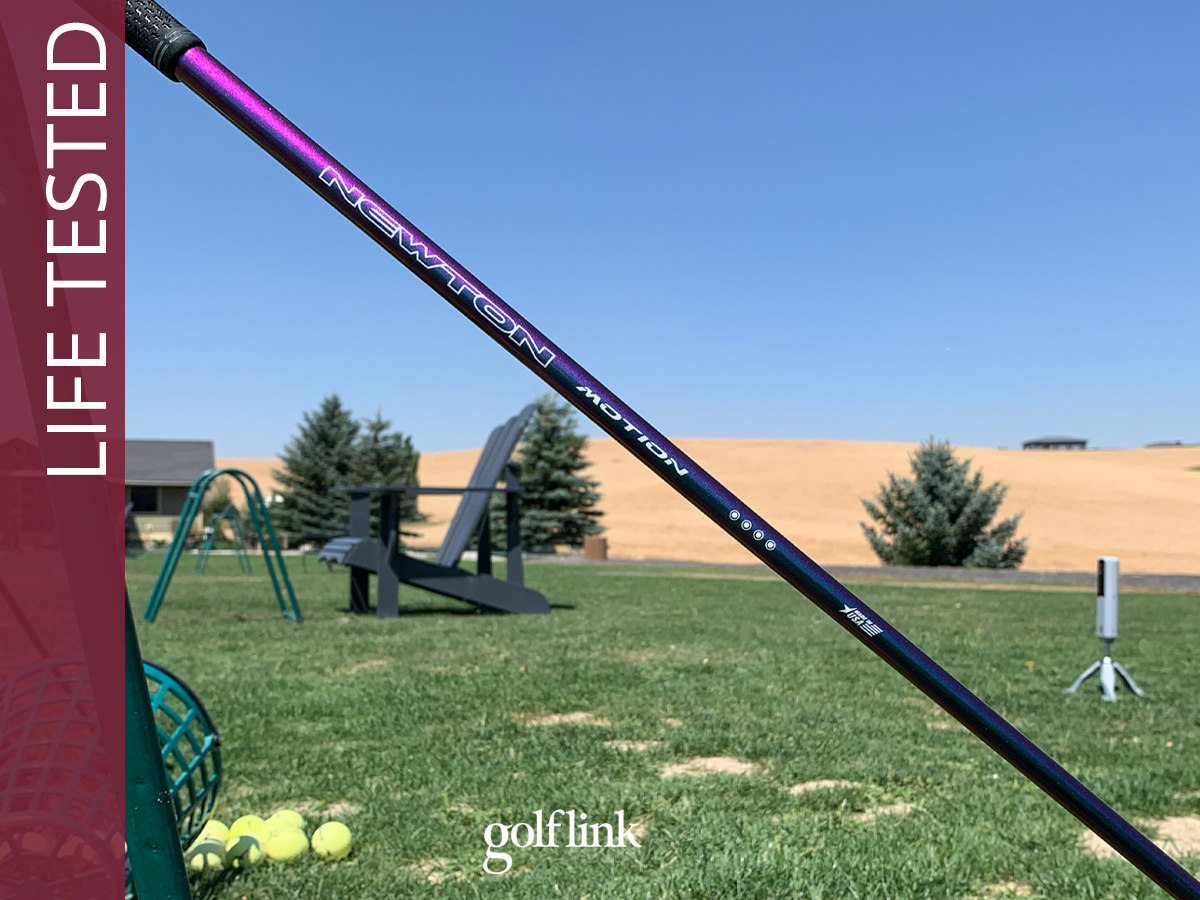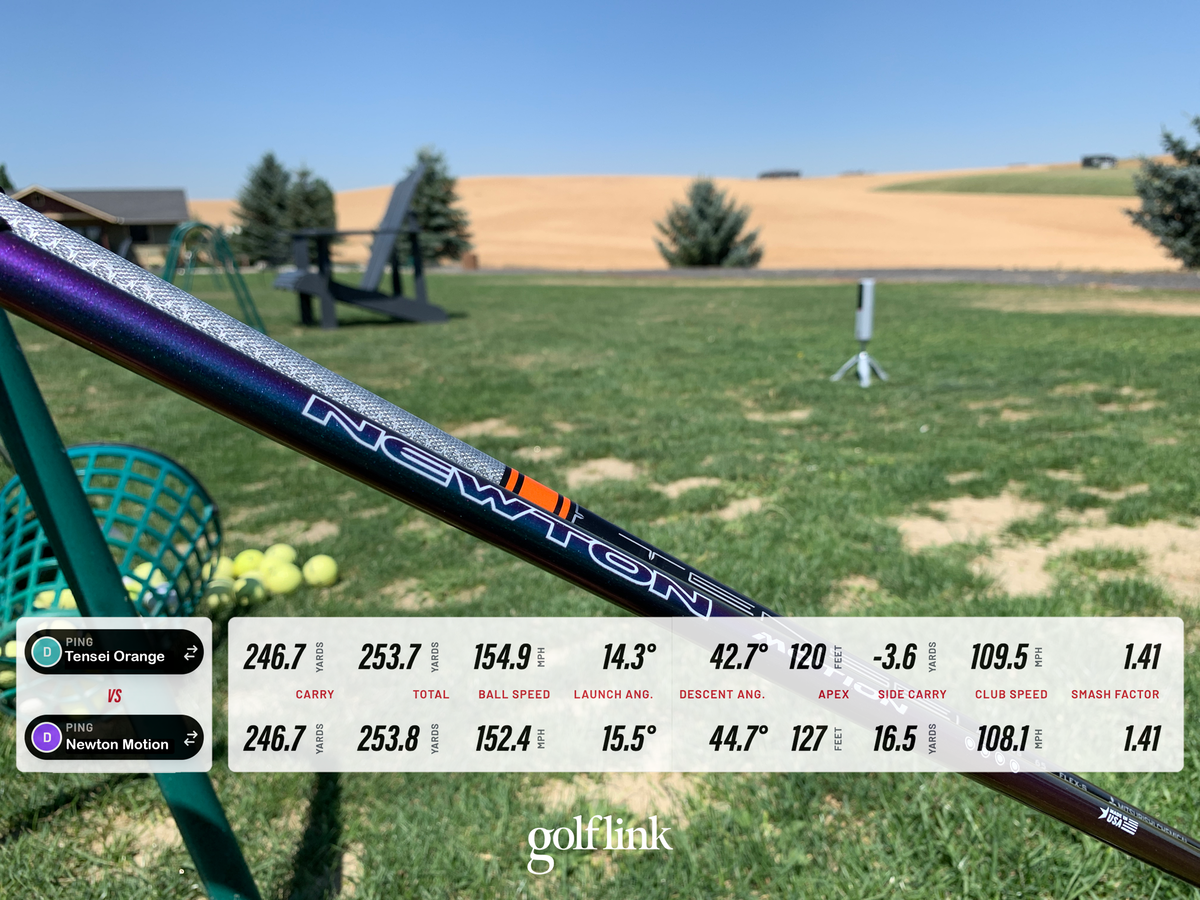Newton Golf Shaft Review: How The Motion Shaft Stacks Up
We put the Newton Motion golf shaft head-to-head against Tensei Orange. Check out the results!

Have you seen these Newton Golf Shafts? You’d remember the signature look if you have – the iridescent purple shaft that turns dark blue and turquoise depending on the light – and if you’ve done any research into Newon’s Motion shafts, you’d certainly remember Newton’s bold claims that their shafts “help you hit the ball straighter, longer, with less effort.”
Variations of that promise have been selling golf equipment for as long as we can all remember. So we put the Newton Motion driver shaft to the test, comparing it head-to-head with the tour-proven Mistubishi Tensei Orange to get a completely unbiased review of how it performs. Check it out.
How We Tested the Newton Motion Driver Shaft
SHOP NEWTONFIND ON AMAZON
Price: $250
For this review, Newton sent me a shaft that as closely as possible matched the shaft in my gamer, a 44-inch 65-gram stiff flex Mitsubishi Tensei Orange, with the appropriate (PING) tip adapter. The Newton shaft checked in 5 grams lighter than my own, at 60g, which is a small difference and the only measurable one I could find.
I took both shafts to the driving range (outdoors) and measured performance on the Rapsoso MLM2Pro launch monitor, hitting drives with each until I felt I had a solid sample size of quality strikes with both.
I did not rotate between the two to offset potential fatigue, nor did I cap the test at a pre-determined number of swings. Given that the test was performed with range balls, ball speed, distance and smash factor numbers may be lower than what you would expect from a premium ball.
Afterwards, I threw out a few of the worst strikes with each shaft, then compared performance.
RAPSODO MLM2PRO
Typical Price: $699
Data Points: 12
|
Newton Motion |
Mitsubishi Tensei Orange |
|
|
Flex |
4 DOT |
Stiff |
|
Weight |
60 grams |
65 grams |
|
Shaft Length |
44 inches |
44 inches |
Newton Motion Driver Shaft Review

The Newton Motion turned out nearly identical numbers as the Tensei Orange shaft
Pros:
- Made in the USA
- Performance proven to match the best in the industry
- Easy system for selecting the proper shaft for your swing
- Built to fit most manufacturer’s heads
- 30-Day window to return or exchange allows you to test the performance for yourself
- Lower price than some premium competitors
Cons:
- At $250 it’s still a bigger investment
Titleist is undeniably the gold standard in golf balls, and the Pro V1 and Pro V1x are automatically the benchmark for any challenger trying to grab consumers' attention. When a company wants to show golfers how good its ball is, it presents data that compares it to the Pro V line.
When I finished testing the Newton Motion driver shaft, that’s the first analogy that came to mind.
That’s not to say that my Mitsubishi Tensei Orange is the Pro V1 of driver shafts, but it’s certainly a tour-proven shaft that has earned its prestigious reputation.
Reviewing the numbers, the Newton Motion shaft was right on pace with the Tensei Orange in just about every category. Aside from launch and trajectory, and a little more draw bias (both of which I'll elaborate on shortly) the two were virtually indistinguishable.
Newton Motion vs. Mitsubishi Tensei Orange Head-to-Head
Here are the detailed results of my head-to-head test to show you exactly how the Newton Motion shaft compares to one of the top premium shafts in the industry.
|
Newton Motion 4 DOT |
Mitsubishi Tensei Orange |
|
|
Carry Distance |
246.7 |
246.7 |
|
Total Distance |
253.8 |
253.7 |
|
Ball Speed |
152.4 |
154.9 |
|
Smash Factor |
1.41 |
1.41 |
|
Launch Angle |
15.5 |
14.3 |
|
Apex |
127 feet |
120 feet |
|
Club Speed |
108.1 |
109.5 |
Distance Comparison

The iridescent Newton driver shaft can look purple, dark blue, or turquoise
When I compared the results of this shaft test, the results were almost indistinguishable.
Carry distances were identical, down to the tenth of a yard. Total distances were separated by just one-tenth of a yard. Smash factor was again, identical.
Club and ball speeds favored my own shaft by 1.5 and 2.5 mph, respectively, which could be attributed to fatigue, since I finished with the Newton Motion shaft. With that in mind, the Newton Motion shaft produced identical distance with a slightly slower average swing speed, so you could infer that with identical swing speeds, I may have seen a few extra yards of distance from the Newton shaft.
The bottom line, however, was that the two shafts churned out impressively similar numbers, which, regardless of the small variances (after all, I’m not a robot), is a win for the Newton Motion shaft, just like when a competitor’s golf ball replicates the performance of a Pro V1.
Launch & Trajectory Comparison
The one area where there was meaningful(ish) separation was launch and trajectory. I’ll preface this with the note that the Tensei Orange shaft is the low-launch, low-spin, counterbalanced option in the Tensei family, and that’s exactly what played out. A more apples-to-apples launch and trajectory comparison might be to put the Tensei Blue (mid-launch) shaft against the Newton Motion.
I launched the Newton Motion driver shaft about one degree higher (14.3 degrees to 15.5 degrees), and saw its apex seven feet higher (127 feet to 120 feet). Naturally, it descended an even two degrees steeper (44.7 degrees compared to 42.7 with the Tensei Orange).
I already launch the ball higher than I’d like, at 14.3 degrees and a 120-foot apex, so given the similarities in other areas, I don’t think I’d switch out of my current shaft into one that launches higher.
However, more golfers could benefit from higher launch and trajectory than lower launch and trajectory. It’s all relative based on what you’re currently playing and your typical launch conditions, but I’d bet most golfers would find the launch conditions from the Newton Motion driver shaft to be favorable.
Is the Newton Motion Shaft More Accurate?
In my test, the Newton Motion shaft produced an average of about 20 yards more draw bias than my gamer.
I can’t say with confidence that you should expect the same results, because I don’t put a lot of stock into average side-carry numbers. You could alternate 40-yard left and right misses with one, and pipe every shot down the middle with the other, and get the same average.
However, if we use an imaginary 45-yard wide fairway, the accuracy numbers become much more clear, and again, quite similar.
Drives with the Newton Motion shaft finished within 23 yards of the target line (so it’s technically an imaginary 46-yard wide fairway) 50 percent of the time. Meanwhile, drives with the Tensei shaft hit that same make-believe fairway 46.2 percent of the time.
This is too small of a sample size to glean any concrete take-aways, we’re talking about 3-dozen total shots, but it does confirm at the very least that the Newton Motion shaft is as good as the best shafts out there.
What to Expect With a Newton Shaft
Ordering a Newton shaft is really easy, which is refreshing because shafts and their various specs have become way more confusing than they need to be.
You simply find your club head speed or average distance on Newton’s table to identify your dot profile, pick your dexterity, and which brand’s adapter you need on the tip.
Rather than assigning each shaft a flex rating (like regular or stiff, for example), Newton uses a dot scale, from 1 Dot to 6 Dot, with 1 Dot shafts having the most flex and fitting the slowest swing speeds, while a 6 Dot shaft is the stiffest shaft for the highest (115+ mph) swing speeds. The 1 Dot shaft weighs 45 grams and each additional dot brings in an extra 5 grams, up to the 70-gram 6 Dot shaft.
The Bottom Line
The Newton Motion driver shaft proved it belongs with the premium shafts in the game. It held its own, and then some, against a shaft that’s been proven in the highest levels. In fact, Newton shafts themselves are gaining popularity on professional tours, particularly the PGA Tour Champions.
Beyond the performance, Newton shafts offer an attractive value. Sure, they’re not cheap at $250, but for comparison’s sake, new Tensei shafts will set you back $350, and I’m confident the Newton Motion shaft performs just as well as those.
When you make any golf equipment purchase, you never want to think about what happens if it doesn’t work out, but Newton offers an excellent 30-day money-back guarantee, which enables you to test the shaft for yourself, on the course and/or on a launch monitor. If you’re not satisfied, or decide you need a different flex, you can return or exchange the shaft within 30 days.
In my opinion, however, it’s more likely that after 30 days you’ll be heading back to Newton to add matching shafts to your fairway woods.